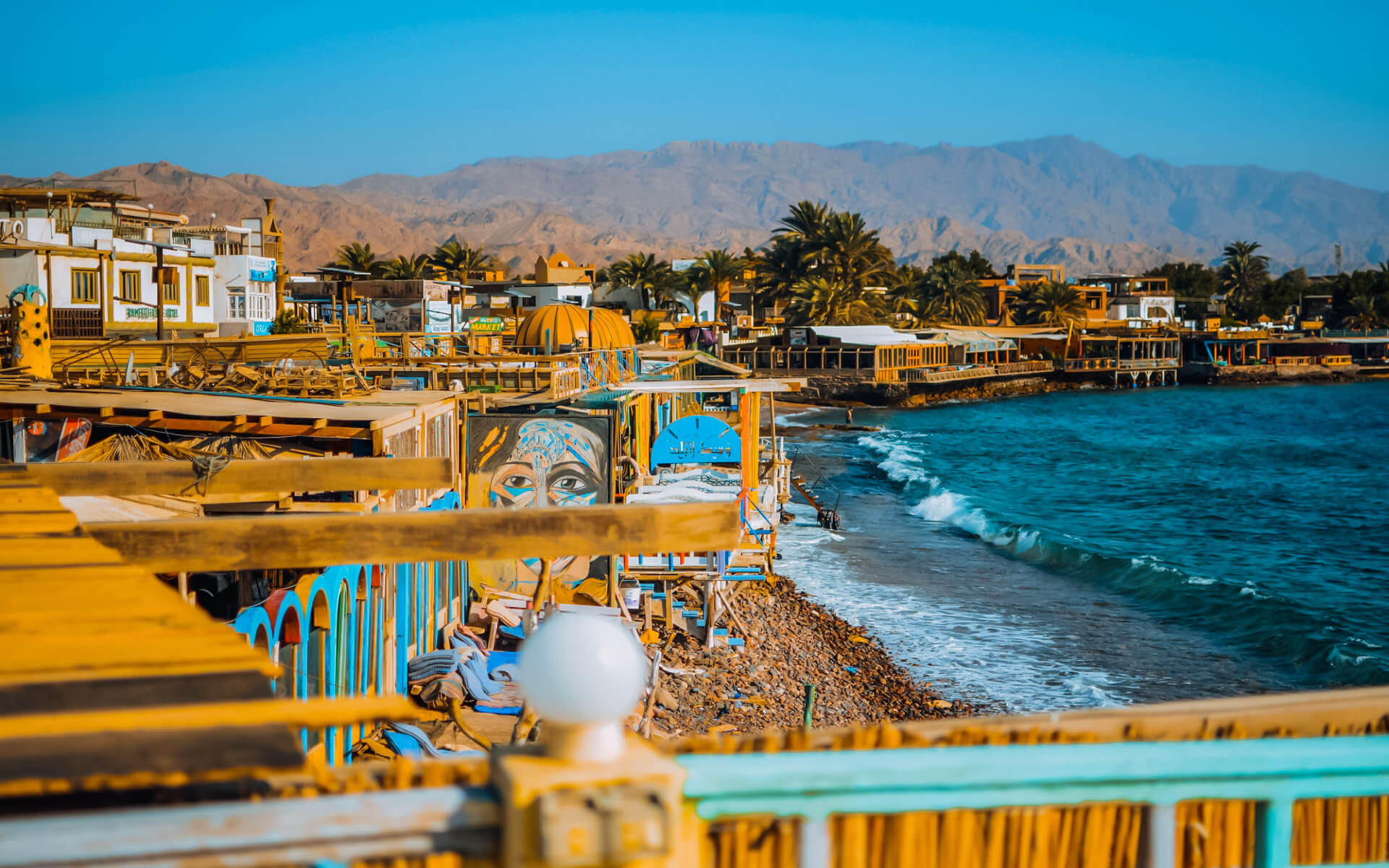Diving and freediving are quite popular in Dahab and need a little more explanation. The reefs here are still in reasonably decent condition near town, and outstanding condition in Protected Areas such as Ras Abu Galoum. Abu Helal, Blue Hole, The Bells, Canyon, Coral Garden, Eel Garden, Lighthouse, Moray Garden, Islands, Three Pools, Gabr El Bint, and Ras Abu Gallum are among the well-known diving destinations.
The Blue Hole is one of the top ten diving destinations in the world and may be dived within safe recreational depths (that is, without going to the arch). Bells / Blue Hole is a very popular and picturesque location. However, be warned that it is busy because to the large number of buses that arrive from Sharm. A typical dive at the Bells, a chimney that drops down to 30 meters perpendicular (a thrilling experience! ), requires excellent open water abilities. Otherwise, you are not permitted to travel beyond 30 yards! Freediving is the new kid on the block in Dahab, due to the highly handy Blue Hole location and an ever-growing number of world-class freedivers training here.
Bedouin Divers
A well-known diving facility on the Red Sea coast in Dahab’s Mashraba region. Bedouin Divers is located at the Bedouin Lodge Hotel and offers Daily Diving, PADI Courses, Camel Dive Safaris, and Boat Dives.
Big Blue Dahab
+20 (0)69 3640 045.
Is a fully equipped 5 Star Gold Palm Padi resort meters from the reef, offering a peaceful and inviting atmosphere excellent for snorkeling and diving. With an emphasis on safety and pleasure, as well as environmental consciousness. Small dive groups with highly skilled instructors and divemasters allow you to enjoy a complete variety of Padi courses and guided dives at reasonable pricing.
Blue Realm
+201227444873, e-mail: info@bluerealmdiving.com. 8am-8pm. mobile +20 122 744 4873;.
Excellent native-run diving facility (offered in English, Dutch, German, French, and Arabic; the owner’s wife is really Dutch). They charge €45 for two dives (plus extra for gear rental). There are package savings available. A 5-day PADI Open Water course here costs €260, which includes all equipment.
BlueSkunk Freedivers
Provides a comprehensive and progressive selection of courses, including Beginner, Intermediate, Advanced, and Deep. The course does not aim to drive you to a new personal best since it prioritizes technique improvement and depth adaptation above increasing depth. First and foremost, safety.
Dahab Divers
+20 69 3640381, +20 10 1113481, e-mail:dive@dahabdivers.com.
PADI 5 star Golden Palm Resort and Diving School near Masbat’s Lighthouse. Staff is kind, the ambiance is pleasant, and the equipment is of high quality. Team Blue Immersion operates the technical diving facilities at Dahab Divers, offering TDI, TecRec, and GUE programs up to Instructor Level. (http://www.blue-immersion.org/ and http://www.dahabdiverstechnical.com/)
Deep BlueDivers
+20 121134668,
Deep BlueDivers is a fully equipped 5 Star Gold Palm Padi resort meters from the coral. We perform our business, which is obviously diving, in the Red Sea. In all of our Red Sea scuba diving adventures, we take satisfaction in being enthusiastic, professional, and individualized. With an emphasis on safety and pleasure, as well as environmental consciousness. Small dive groups with highly skilled instructors and divemasters allow you to enjoy a complete variety of Padi courses and guided dives at reasonable pricing.
Desert Divers
Diving, climbing, trekking, and freediving are all options. Said, the owner, was the first Bedouin in Dahab to learn to dive approximately 20 years ago. On the main bay’s beach (Masbat Bay, between the bridge and Lighthouse Reef). Ideal for scuba diving and freediving (PADI 5 Star Gold Palm Resort, Home of the Camel Diving Safari and AIDA Freediving Centre). Given their Bedouin background, they have also pioneered professional hiking and rock climbing. Their attempts to mix adventure sports and tourism with the Bedouin population are well-received; they recently received an EU grant for developing and promoting sustainable tourism in Sinai.
“Dive In Dahab”
Andreas (Andy) Tischer created the company in 1999. Hans Lange joined Dive In as Andy’s partner in 2006. Hans exited the Dive. iDive Dahab was developed in 2011.
Dive The Gap
Is a scuba diving gap year and professional development firm based in a PADI 5-Star Instructor Development Resort and National Geographic Centre. Dive The Gap is a UK-based company that mostly works in Dahab and offers a variety of scuba diving programs. Almost every PADI course, from Open Water through Instructor and PADI Master Scuba Diver Trainer, is offered, as well as a comprehensive selection of PADI specialties, diving safaris, and recreational diving. Packages are also available, and a crew is on-site. Call 020 8133 4481 (+44 20 8133 4481) and you will be connected to the staff in Egypt at no additional cost.
Dive Pro Dahab
Is a firm founded by divers for divers in order to assist them get the most out of their diving holiday. Because it is spread out around the Red Sea, it can provide divers with services wherever they go.
Divers Down Under (DDU)
It is attached to a 70-room hotel and hostel lodge and provides a broad choice of entry-level PADI courses in many languages, divemaster internships, specialty courses, and technical diving experiences (INTD and PADI-Dsat).
Freedive Dahab
+20 165093752, e-mail: info@freedivedahab.com.
Lotta Ericson (former World Record holder) and Linda Paganelli founded the company (Italian Champion). Freedive Dahab is an Instructor Training Center, as well as an SSI and AIDA school, offering all levels of classes and private instruction. Freedive Dahab also has a freediving store where you may purchase or rent any freediving equipment you might require. Freedive Dahab also hosts National and World Record attempts, as well as competitions like as the Triple Depth competition.
H2O Divers Dahab
Professional, experienced, and qualified instructors with over ten years of diving expertise in Dahab. A welcoming group of fluent English, French, German, Dutch, and Arabic speakers providing a comprehensive variety of PADI courses. Masbat Bay, Dahab’s major bay, is right in the middle of the resort. Lighthouse Reef, Mashraba, and Bannerfish Bay are all just outside their door. Bannerfish Bay’s easy access is just outside their door, while Lighthouse and Mashraba are only a two-minute walk away.
iDive Dahab
+20 1118444097.
The diving facility of the Jowhara Hotel is well constructed. In addition to daily dive excursions, iDive provides a full variety of PADI, SSI, and CMAS courses. Safaris and overnight vacations are also available. A Marine Research center is part of the iDive center and provides an excellent chance to learn more about marine sciences. iDive and its Open Ocean Center are launching a number of initiatives to conserve the water. They routinely host overseas institutions on field excursions or as part of research initiatives.
Mirage Divers – Diving center
+20 693641476, fax: +20 693641476, e-mail: info@miragedivers.com.
Owned and operated by extremely skilled Bedouins, they always try their utmost to provide genuine social diving vacations that include both safety and pleasure while experiencing a completely different culture in a genuinely unique setting. Their groups are usually small, and each diver receives individualized care.
Nesima Diving Center
+20 69 3640320.
The French-run diving facility is often regarded as the finest in town. They do demand a premium in terms of pricing, with two dives costing €47 (plus €20/day for gear rental). There are package savings available. A 5-day PADI Open Water course costs €302 in this location.
Poseidon Divers
Learn technical diving or undertake recreational dives or courses in a safe and professional manner. It is the only PADI Career Development Center in town, as well as a PSA and TDI Instructor facility (the only one in Egypt), so there will be no lack of divers if you do your PADI DiveMaster or Instructor course here, which is a clear benefit for the quality of your course.
Red Sea Relax PADI 5 Star National Geographic Instructor Development Resort
+20 69 3641 308.
A British-run diving business with an excellent beachside site in downtown Dahab, meters from the teeming reefs but yet close to the city and contemporary facilities. On-site lodging is provided in the form of suite rooms or a bed in the dormitory complex, which is completely free for divers. PADI diving courses vary from beginner to professional Open Water Instructor, and daily diving to any of the 20 local reefs is available for those who are already certified. Excursions via boat and Camel Dive Safaris are also available.
Reef 2000 Diving Center
PADI 5* Gold Palm Resort and IANTD technological facilities by Bedouin Moon Hotel. It provides a broad variety of diving lessons, from beginning to technical.
Sea Dancer Dive Center
Small, professionally operated establishment on the seafront. Provides a complete variety of courses as well as guided dives. The staff is informed, experienced, eager, and courteous, and the equipment is of high quality and well-maintained.
Sea Pioneer Dive Club
Dive Centre is located immediately across the street from Dahab’s popular Lighthouse diving location. For restricted and open water dives, we are less than a minute’s walk from the shore. In addition to introductory dives, we offer PADI courses in Open Water, Advanced, Rescue, Dive Master, and many more specialties. On request, we may also arrange you lodging and airport transportation.
World of freediving
World of Freediving International AIDA freediving School is a freediving school in Dahab, South Sinai, Egypt. They provide a diverse choice of freediving classes and training opportunities for divers of all skill levels, including AIDA Instructor Courses. All of the courses are AIDA courses, and all of the teachers are AIDA certified.
Zen Sea
Fun dives, PADI courses, and yoga diving are all available.
Rock climbing
Desert Divers have pioneered the development of rock climbing in Sinai. They can arrange for Wadi Gnai licenses, equipment rental, transportation, guides, and anything else you may want. They just released the Sinai Rock Climbing Guide, which includes topos and route descriptions. Their instructors are eager to share/offer information to experienced climbers who can’self-guide,’ or they can assist you improve your climbing skills with basic and advanced technique courses.
St. Catherine also offers some of the best trad climbing and bouldering in the world. Base yourself in the hamlet at Fox Camp or Sheikh Mousa Bedouin Camp for convenient access to more than 60 trails (5 minutes to 2 hours). The pitches are all lengthy multipitch (7+ pitch), however there is a large variety of grades. If you’re in a group, it’s a lot of fun to ride a camel far into the desert, where you’ll discover unclimbed lines practically everywhere you look! No bolting is permitted at St Catherine, and please respect the sacred mountains of Mt Sinai and St Katherine by taking the ancient pilgrimage trails rather than climbing.
Sandboarding
Sandboarding is supposed to have begun in Egypt during the Pharaohs’ reign, when they slid down dunes on pieces of wood. However, it has only just begun to take center stage as one of the most thrilling outdoor adventure sports. Today, the sport has developed in many nations with picturesque surroundings, such as Namibia, Peru in Latin America, Australia, the Western United States, and Dubai in the United Arab Emirates, with an ever-increasing global following.
Yoga, Reiki, Chi Gong and more
Yoga, whether ashtanga, hatha, or kundalini, is becoming more popular in Dahab. Yoga on adjacent Mount Sinai is a popular attraction, as are full-moon retreats into the surrounding wadis (desert), which take advantage of the Sinai desert’s calm and openness. People are flocking to Dahab for vacations, and yoga for Christmas has quickly become a popular activity.
Throughout the year, the El Salam Camp and Yoga Shala offers daily lessons as well as regular retreats during peak season. Currently, classes are accessible in both English and Russian.


